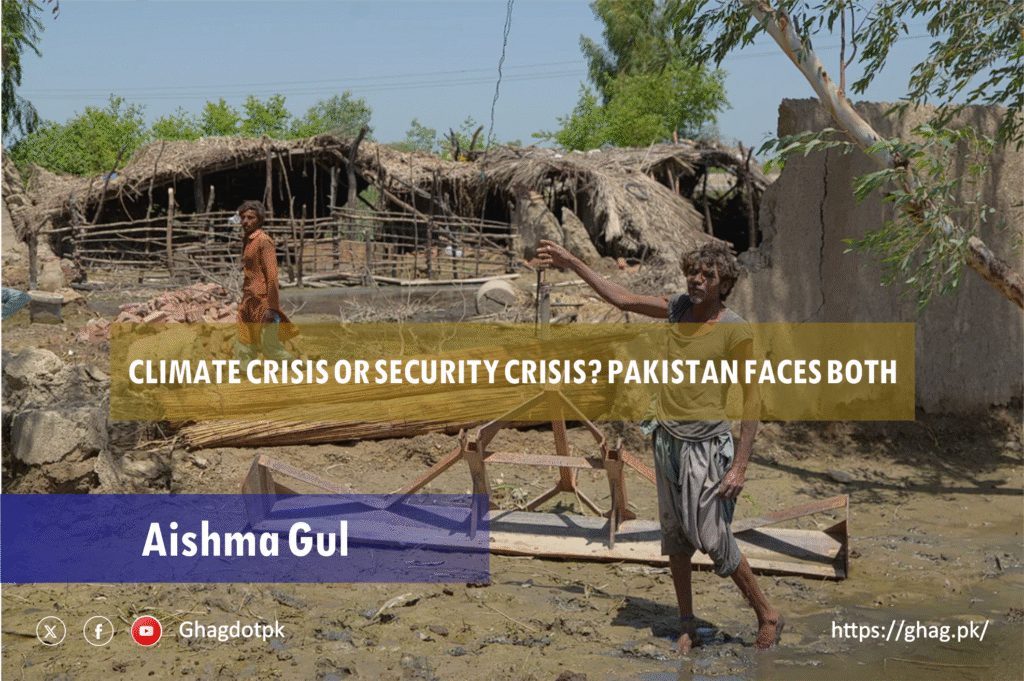By Aishma Gul
Floods: From Natural Disaster to Security Crisis
“When the last tree is cut, the last fish is caught, and the last river is polluted; when to breathe the air is sickening, you will realize, too late, that wealth is not in bank accounts and that you can’t eat money.” — Alanis Obomsawin
Pakistan finds itself trapped between nature’s rage and human weakness. More than half of the 170+ people killed in recent floods were children. This paints a harsh picture of a country stuck between climate unfairness and broken systems. The crisis goes way beyond bad weather. It threatens national security, ruins the economy, and puts human lives at risk.
The Current Disaster: Death Toll Numbers
The 2025 monsoon season has brought terrible destruction across Pakistan. Since June 26, at least 216 people have died from monsoon disasters. This includes 101 children. Punjab has seen the worst damage with 135 deaths. Khyber Pakhtunkhwa follows with 42 deaths, Sindh has 21, and Balochistan recorded 16 deaths.
More than 580 people got injured. Nearly 800 homes were destroyed. Around 200 farm animals died. The National Disaster Management Authority says four more monsoon waves will hit before August 2025. Rain will be 60-70% heavier than last year.
Why Pakistan Gets Hit So Hard?
Pakistan’s flood problems come from geography, climate change, and government failures mixed together. The country sits in a climate danger zone. Past flooding covered about one-third of the entire country. It affected 33 million people and cost $14.8 billion in damage plus $15.2 billion in economic losses.
The nation has more than 13,000 glaciers in Gilgit-Baltistan’s “third pole” area. Extreme heat reaching 48°C makes these glaciers melt fast. This water flows into rivers that are already full from monsoon rains. The natural process becomes deadly when mixed with illegal building in riverbeds and messy city growth.
Pakistan produces less than 0.5% of world greenhouse gases. But its people are 15 times more likely to die from climate disasters than folks in safer places. This shows one of the worst examples of climate unfairness anywhere on Earth.
The Security Problem: When Weather Turns Into War
Climate change in Pakistan isn’t just about the environment. It directly threatens national security. The security risks show up in many ways:
- People’s Safety Crisis: Floods force millions to leave their homes. This creates mass movement that strains city resources and breaks social systems. The 2022 floods moved 30 million people. That’s more refugees than some entire countries have people.
- Regional Tensions: Pakistan wants India to follow the 1960 Indus Waters Treaty. This shows how climate disasters mix with regional politics. Defense Minister Khawaja Asif warned about “water warfare.” This proves flood management becomes both diplomatic and security business. India stays quiet about early flood warnings. This forces Pakistan to use satellites and field reports, creating information gaps that kill people.
- Financial Problems: Annual disaster relief costs more than prevention spending. The cycle of destruction and rebuilding drains national money that could make the economy and development stronger.
World Examples: How Other Countries Beat Floods
Several nations offer good examples of flood control that Pakistan could copy:
- Netherlands Water Control: The Dutch “live with water” instead of fighting it. They have smart early warning systems, planned flood zones, and city planning that works with water flow instead of blocking it.
- Bangladesh Community Methods: Despite similar dangers, Bangladesh cut flood deaths through community disaster prep. Local volunteers learn early warning sharing and evacuation steps.
- Singapore City Solutions: This city-state manages water through underground drains, water-smart city design, and real-time monitoring. Pakistan’s big cities could adapt these ideas.
Army and Civilian Response
Pakistan’s military flood response shows institutional strength under extreme pressure. Army helicopters ran rescue missions across several provinces at once. This proves coordination skills that go beyond regular security duties.
Military flood involvement shows a bigger pattern. Armed forces fill gaps when civilian disaster management can’t handle everything. This double-duty ability strengthens both disaster response and overall institutional strength.
Moving Forward: From Reaction to Strength
Experts point out several key steps for building flood resistance:
- Local Control: Giving municipal and district bodies funding and independence can improve local response abilities. Communities near flood risks often understand local patterns better than distant bureaucrats.
- Early Warning Networks: Pakistan needs complete early warning systems that combine glacier watching, weather forecasting, and community communication. The current dependence on post-disaster satellite images must change toward prediction abilities.
- Infrastructure Changes: The Living Indus Initiative must become real, combining glacier, river, and city planning across province borders. This needs constitutional and administrative changes that put water security first.
- Climate Fund: Of the $10 billion promised after 2022 floods, only $2.8 billion actually came. Pakistan must develop better ways to access international climate funding while building domestic resilience money.
International Stakes: A Regional Security Matter
Iran promised support during current floods, including President Masoud Pezeshkian’s planned Islamabad visit. This shows how climate diplomacy increasingly shapes regional relationships. Countries that give effective disaster help gain influence and goodwill.
The Innovation Challenge
Pakistan added 17 GW of solar power in 2024, but the old electrical grid can’t handle renewable energy well. This technology mismatch shows broader climate adaptation challenges. Having green technology without supporting infrastructure creates new weaknesses.
The answer needs adaptive, Pakistan-specific approaches rather than copying models designed for different situations. This includes special trade access for sustainably made goods, grant-based climate finance, and subsidized transitional technologies.
Beyond Survival: Building Anti-Fragile Systems
“Anti-fragility” means systems that get stronger under stress. This offers a framework for Pakistan’s climate response. Instead of just recovering from floods, the goal should be building systems that improve through each disaster experience.
This needs shifting from relief-focused approaches toward resilience-building investments. Community-based early warning systems, climate-smart farming, and ecosystem restoration create abilities that strengthen with use.
Wrapping Up: Choosing Between Strength and Ruin
Pakistan faces a harsh choice between change and continued weakness. The current flood crisis killed over 216 people and caused widespread destruction. It represents both tragedy and opportunity for basic change.
Moving forward means accepting that floods aren’t temporary disasters but permanent parts of Pakistan’s climate reality. Success demands institutional reform, international cooperation, and recognizing that climate security equals national security.
The bravery shown by Pakistan Army pilots doing rooftop rescues must match the political bravery to make systemic changes. The choice is clear: build strength now or face ruin repeatedly. The rising waters won’t wait for convenient solutions.






